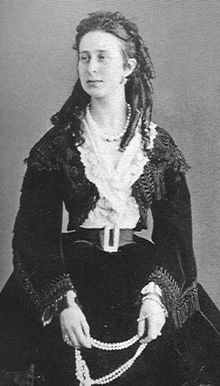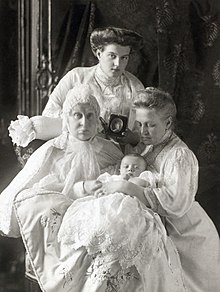Princess Alexandra of Saxe-Altenburg
 From Wikipedia the free encyclopedia
From Wikipedia the free encyclopedia
| Princess Alexandra | |||||
|---|---|---|---|---|---|
| Grand Duchess Alexandra Iosifovna of Russia | |||||
 Alexandra in 1860 | |||||
| Born | 8 July 1830 Altenburg, Duchy of Saxe-Altenburg | ||||
| Died | 6 July 1911 (aged 80) Saint Petersburg, Russian Empire | ||||
| Burial | Grand Ducal Burial Vault, St. Petersburg, Russian Empire | ||||
| Spouse | |||||
| Issue | Grand Duke Nicholas Constantinovich Olga, Queen of the Hellenes Vera, Duchess Eugen of Württemberg Grand Duke Constantine Constantinovich Grand Duke Dimitri Constantinovich Grand Duke Vyacheslav Constantinovich | ||||
| |||||
| House | Saxe-Altenburg | ||||
| Father | Joseph, Duke of Saxe-Altenburg | ||||
| Mother | Duchess Amelia of Württemberg | ||||
| Religion | Russian Orthodox prev. Lutheranism | ||||
Grand Duchess Alexandra Iosifovna of Russia (born Princess Alexandra of Saxe-Altenburg, 8 July 1830 – 6 July 1911) was the fifth daughter of Joseph, Duke of Saxe-Altenburg and Duchess Amelia of Württemberg.
Early life[edit]

Alexandra's parents were married on 24 April 1817, at Kirchheim unter Teck. Alexandra had five sisters: Marie, Pauline, Henriette, Elisabeth, and Luise.
Alexandra's portrait was painted by the fashionable court artist Joseph Karl Stieler.
Marriage and issue[edit]

In the summer of 1846, she met Grand Duke Konstantin Nikolayevich of Russia when he visited Altenburg. He was the second son of Nicholas I, Emperor of Russia, and Empress Alexandra Feodorovna, née Princess Charlotte of Prussia.
Konstantin stayed for a few days at Alexandra's father's castle. His visit there had been arranged by Alexandra's aunt, Grand Duchess Elena Pavlovna, who had been born Princess Charlotte of Württemberg. Elena and Alexandra's mother were both descended from Frederick II Eugene, Duke of Württemberg. Elena was married to Grand Duke Michael Pavlovich, the younger brother of Tsar Nicholas I. Elena Pavlovna was therefore Konstantin's aunt by marriage and Alexandra's aunt by birth. Elena was a strong influence over Konstantin, who admired her intellect and progressive views. She had literary interests and was musical, founding the St Petersburg Conservatoire, and the young Konstantin often spent time at Elena's home and salon in St Petersburg.
Konstantin was intellectual and liberal, whereas Alexandra was conservative and rather high spirited. Although their temperaments differed, they both shared an interest in music, and enjoyed playing duets at the piano. Konstantin was captivated by Alexandra's youthful beauty: she being tall, slender and attractive. He quickly became besotted, and was eager to marry her "I don't know what is happening to me. It is as if I am a completely new person. Just one thought moves me, just one image fills my eyes: forever and only she, my angel, my universe. I really do think I’m in love. However, what can it mean? I've only know her just a few hours and I'm already up to my ears in Passion".[1] She was only sixteen and Konstantin nineteen; they were engaged but had to wait two more years before they could finally marry.
Alexandra arrived in Russia on 12 October 1847, and was greeted by much fanfare and popular celebration, with jubilant crowds lining the streets and balconies. It was said that Alexandra looked so much like her fiancé's sister, the Grand Duchess Alexandra Nikolayevna, who died in childbirth, that her prospective mother-in-law burst into tears at their first meeting.[2]
In February 1848, Alexandra converted to Russian Orthodoxy, taking the name of Grand Duchess Alexandra Iosifovna, which reflected her father's name Joseph (unlike many princesses she took a patronymic, choosing to reflect her parentage rather than the usual religious or dynastic associations which was also possible because Iosif was a common name in Russia).
Alexandra and Konstantin were married in the Winter Palace in St Petersburg, on 11 September 1848. Konstantin received the Marble Palace in St Petersburg as a wedding gift from his parents. Strelna on the Gulf of Finland, which Konstantin inherited when aged four, was the wedded couple's country retreat. The lively Grand Duchess Alexandra Iosifovna took a particular interest in the grounds at Strelna, establishing a free school of gardening, where she taught classes herself. There were also educational toys for the children: a wooden mast and trampoline for gymnastics, and the transplanted cabin of one of Konstantin's frigates.
A year after their marriage Konstantin inherited the Pavlovsk Palace, situated 19 miles to the south of St Petersburg, from his uncle Grand Duke Michael Pavlovich. The public was admitted to the fine park in its grounds. The Grand-Ducal family supported an impressive concert hall situated at Pavlovsk station, which proved popular with the middle classes, and attracted names such as Johann Strauss II, Franz Liszt, and Hector Berlioz.
Alexandra and Konstantin later acquired the palace of Oreanda in Crimea, which had originally been built by Tsarina Alexandra Feodorovna and left to her second son for his retirement.
Konstantin and Alexandra had 6 children:
- Nikolai Konstantinovich (1850–1918); married 1882, Nadejda Alexandrovna von Dreyer.
- Olga Konstantinovna, Queen of the Hellenes (1851–1926); married 1867, George I of Greece and is an ancestor of both Felipe VI of Spain and Charles III of the United Kingdom
- Vera Konstantinovna (1854–1912); married 1874, Duke Eugen of Württemberg.
- Konstantin Konstantinovich (1858–1915); married 1884, Princess Elisabeth of Saxe-Altenburg.
- Dmitry Konstantinovich (1860–1919); died unmarried.
- Vyacheslav Konstantinovich (1862–1879); died unmarried.
Family crisis[edit]

In 1867, Alexandra's eldest daughter, Olga, married King George I of Greece. She was only sixteen, and Konstantin was initially reluctant for her to marry so young. In July 1868, Olga's first child was born and was named Konstantin after his grandfather. The beginning of their daughter's family coincided with the start of the breakdown of Alexandra and Konstantin's marriage.
Although he was only forty, Konstantin's struggles and travails of the previous decade— naval and judiciary reforms, the freeing of the serfs—had prematurely aged him. As his brother Tsar Alexander II turned away from the reform that had marked his first decade on the throne, Konstantin's influence began to wane and he began to focus more on his personal life. After twenty years of marriage he had drifted away from his wife. Konstantin's heavy workload, and the couple's divergent political views and interests had over the years slowly torn away at their relationship. Alexandra was as conservative as her husband was liberal, and she had learnt to concern herself with her own society and mysticism. Soon, Konstantin turned elsewhere for sexual intimacy.[3]
At the end of the 1860s, Konstantin embarked on an affair and conceived an illegitimate daughter, Marie Condousso. In the 1880s, Marie was sent to Greece, later serving as lady in waiting to her half sister, Queen Olga. Marie eventually married a Greek banker.[3]
Soon after the birth of Marie, Konstantin began a new liaison. Around 1868, Konstantin began to pursue Anna Vasilyevna Kuznetsova, a young dancer from the St Petersburg Conservatoire. She was the illegitimate daughter of ballerina Tatyana Markyanovna Kuznetsova and actor Vasily Andreyevich Karatygin. Anna was twenty years younger than Konstantin and in 1873 she gave birth to their first child. Four more would follow.[4]
Konstantin bought his mistress a large, comfortable dacha on his estate at Pavlovsk; thereby lodging his second family in close proximity to Alexandra, whom he now referred to as his "government–issue wife". By this act Konstantin gave ammunition to his political enemies, with Russian society reacting to the scandal by siding with his suffering wife, Alexandra, who tried to bear his infidelity with dignity.
In 1874, fresh scandal erupted when it was discovered that Alexandra and Konstantin's eldest son, Grand Duke Nikolay Konstantinovich, who had lived a dissipated life and had revolutionary ideas, had stolen three valuable diamonds from an icon in Alexandra's private bedroom, aided by his mistress, an American courtesan. Alexandra's twenty-four-year-old son was found guilty, declared insane, and banished for life to Central Asia. Alexandra suffered another bitter blow when in 1879, her youngest son, Vyacheslav, died unexpectedly from a brain haemorrhage.
Husband's illness and death[edit]

In June 1889, Alexandra's 18-year-old granddaughter, Princess Alexandra of Greece, returned to Russia to marry Grand Duke Paul, who was the younger brother of Tsar Alexander III. Towards the end of the wedding celebrations, Konstantin suffered a stroke. This was followed in August 1889 by a severe stroke, which left him unable to walk or speak.
For the remaining three years of his life Konstantin lived with his wife in her favourite palace Pavlovsk, having a wing of the building to himself. He was confined to a bath chair, and Alexandra saw to it that Konstantin was denied contact with his mistress and illegitimate offspring.[5] Alexandra's grandson, Christopher of Greece, wrote in his memoirs that Konstantin became so frustrated with being under Alexandra's control that he one day grabbed her by the hair and beat her with his stick.[5] Seeing as Christopher would have only been four years old at the time of Konstantin's death, it is difficult to know the full truth of this story.
Despite his illness, Konstantin tried to amuse himself as best he could. His grand-nephew Cyril Vladimirovich remembered skating parties at Pavlovsk, where Konstantin would watch from his sledge, and how he always "smelt of cigars".[6] Cyril found Alexandra a formidable woman, with her "high pitched voice....driving about in an open carriage with a kind of awning over it, which could be opened and closed like an umbrella. I have never seen anything quite the same anywhere else, and think that she was the only person in the world who had such an ingenious cover to her carriage".[7]
When Konstantin died, in January 1892, Alexandra arranged for his mistress Anna to visit Pavlovsk and pray at Konstantin's bedside.
Archives[edit]
Alexandra's letters to her daughter, Queen Olga of Greece, between 1867 and 1877 are preserved in the "Aleksandra Iosifovna letters to Queen Olga of Greece" collection in the Hoover Institution Archives (Stanford, California, USA).[8]
Alexandra's letters to Princess Florestine of Monaco, written between 1873 and 1879, are preserved in the State Archive of Stuttgart (Hauptstaatsarchiv Stuttgart) in Stuttgart, Germany.[9]
Ancestry[edit]
| Ancestors of Princess Alexandra of Saxe-Altenburg |
|---|
Notes[edit]
- ^ King and Wilson, p.12.
- ^ Zeepvat, p.67.
- ^ a b King and Wilson, p.39.
- ^ Zeepvat, p.71.
- ^ a b Zeepvat, p.75.
- ^ Kirill, p.17.
- ^ Kirill, p.18.
- ^ "Aleksandra Iosifovna letters to Queen Olga of Greece". Hoover Institution Library & Archives. Retrieved 1 October 2021.
- ^ "Briefe der Großfürstin Alexandra Josephovna von Russland an Florestine". Hauptstaatsarchiv Stuttgart. Retrieved 25 November 2021.
Bibliography[edit]
- King, Greg, and Wilson, Penny. Gilded Prism. Eurohistory, 2006. ISBN 0-9771961-4-3
- Zeepvat, Charlotte. Romanov Autumn. Sutton Publishing, 2000. ISBN 0-7509-2739-9
- Kirill Vladimirovich, Grand Duke. My Life in Russia’s Service. London: Selwyn and Blount, 1939.